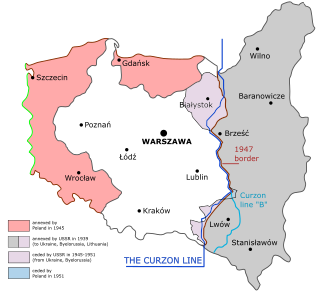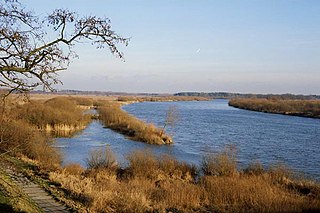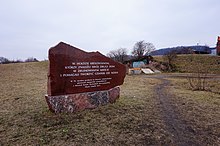The lands of Belarus during the Middle Ages became part of Kievan Rus' and were split between different regional principalities, including Polotsk, Turov, Vitebsk, and others. Following the Mongol invasions of the 13th century, these lands were absorbed by the Grand Duchy of Lithuania, which later was merged into the Polish–Lithuanian Commonwealth in the 16th century.

The Curzon Line was a proposed demarcation line between the Second Polish Republic and the Soviet Union, two new states emerging after World War I. Based on a suggestion by Herbert James Paton, it was first proposed in 1919 by Lord Curzon, the British Foreign Secretary, to the Supreme War Council as a diplomatic basis for a future border agreement.
The Poles come from different West Slavic tribes living on territories belonging later to Poland in the early Middle Ages.

Seventeen days after the German invasion of Poland in 1939, which marked the beginning of the Second World War, the Soviet Union entered the eastern regions of Poland and annexed territories totalling 201,015 square kilometres (77,612 sq mi) with a population of 13,299,000. Inhabitants besides ethnic Poles included Belarusian and Ukrainian major population groups, and also Czechs, Lithuanians, Jews, and other minority groups.

Polesia, also called Polissia, Polesie, or Polesye, is a natural (geographic) and historical region in Eastern Europe within the bigger East European Plain, including part of eastern Poland and the Belarus–Ukraine border region. This region should not be confused with parts of Russia also traditionally called "Polesie".

The Treaty of Riga was signed in Riga, Latvia, on 18 March 1921 between Poland on one side and Soviet Russia and Soviet Ukraine on the other, ending the Polish–Soviet War (1919–1921). The chief negotiators of the peace were Jan Dąbski for the Polish side and Adolph Joffe for the Soviet side.

Volhynia or Volynia is a historic region in Central and Eastern Europe, between southeastern Poland, southwestern Belarus, and northwestern Ukraine. The borders of the region are not clearly defined, but in Ukraine it is roughly equivalent to Volyn and Rivne Oblasts; the territory that still carries the name is Volyn Oblast.

Podlachia, also known by its Polish name Podlasie, is a historical region in north-eastern Poland. Its largest city is Białystok, whereas the historical capital is Drohiczyn.

Eastern Borderlands or simply Borderlands was a term coined for the eastern part of the Second Polish Republic during the interwar period (1918–1939). Largely agricultural and extensively multi-ethnic with a Polish minority, it amounted to nearly half of the territory of interwar Poland. Historically situated in the eastern Polish–Lithuanian Commonwealth, following the 18th-century foreign partitions it was divided between the Empires of Russia and Austria-Hungary, and ceded to Poland in 1921 after the Treaty of Riga. As a result of the post-World War II border changes, all of the territory was ceded to the USSR, and none of it is in modern Poland.

The Bug or Western Bug is a major river in Central Europe that flows through Belarus (border), Poland, and Ukraine, with a total length of 774 kilometres (481 mi). A tributary of the Narew, the Bug forms part of the border between Belarus and Poland for 178 kilometres (111 mi) and part of the border between Ukraine and Poland for 185 kilometres (115 mi).

Western Belorussia or Western Belarus is a historical region of modern-day Belarus which belonged to the Second Polish Republic during the interwar period. For twenty years before the 1939 invasion of Poland, it was the northern part of the Polish Kresy macroregion. Following the end of World War II in Europe, most of Western Belorussia was ceded to the Soviet Union by the Allies, while some of it, including Białystok, was given to the Polish People's Republic. Until the dissolution of the Soviet Union in 1991, Western Belorussia formed the western part of the Byelorussian Soviet Socialist Republic (BSSR). Today, it constitutes the west of modern Belarus.

The Polish population transfers in 1944–1946 from the eastern half of prewar Poland, were the forced migrations of Poles toward the end and in the aftermath of World War II. These were the result of a Soviet Union policy that had been ratified by the main Allies of World War II. Similarly, the Soviet Union had enforced policies between 1939 and 1941 which targeted and expelled ethnic Poles residing in the Soviet zone of occupation following the Nazi-Soviet invasion of Poland. The second wave of expulsions resulted from the retaking of Poland from the Wehrmacht by the Red Army. The USSR took over territory for its western republics.

The population exchange between Poland and Soviet Ukraine at the end of World War II was based on a treaty signed on 9 September 1944 by the Ukrainian SSR with the newly-formed Polish Committee of National Liberation (PKWN). The exchange stipulated the transfer of ethnic Ukrainians who had Polish citizenship before September 17, 1939 to the Ukrainian SSR and of ethnic Poles and Jews who had Polish citizenship before September 17, 1939 to post-war Poland, in accordance with the resolutions of the Yalta and Tehran conferences and the plans about the new Poland–Ukraine border. Similar agreements were signed with the Byelorussian SSR and the Lithuanian SSR ; the three documents are commonly known as the Republican Agreements.
The repatriation of Poles in 1955–1959, also known as the second repatriation, to distinguish it from the first repatriation in 1944–1946, was the second wave of forced repatriation of Poles living in the territories annexed by the Soviet Union in the aftermath of World War II. The widely used term repatriation, promoted by decades of Polish communist propaganda, is a euphemism for acts of expatriation.

The 1951 Polish-Soviet territorial exchange, also known as the Polish-Soviet border adjustment treaty of 1951, was a border agreement signed in Moscow between the Republic of Poland and the Soviet Union. It involved approximately 480 km2 (185 sq mi) of land along their shared border. The treaty was signed on February 15, 1951, ratified by Poland on May 28, 1951, and by the Soviet Union on May 31. It modified the border treaty of August 16, 1945, and came into effect on June 5, 1951. Since Poland was a satellite state within the Soviet sphere of influence, the exchange favored the Soviet Union economically due to the valuable coal deposits relinquished by Poland. Following the agreement, the Soviets constructed four large coal mines within eight years, with a combined annual mining capacity of 15 million tons.
Historically, Białystok has been a destination for internal and foreign immigration, especially from Central and Eastern Europe. In addition to the Polish minority in 19th century, there was a significant Jewish majority in Białystok. According to Russian census of 1897, out of the total population of 66,000, Jews constituted 41,900. In 1936, Białystok had a population of 99,722, of whom: 50.9% (50,758) were Poles, 42.6% (42,482) Jews, 2.1% (2,094) Germans and 0.4% (359) Russians. World War II changed all of this, in 1939, ca. 107,000 persons lived in Białystok, but in 1946 – only 56,759, and to this day there is much less ethnic diversity than in the previous 300 years of the city's history. Currently the city's population is 97% Polish, 2.5% Belarusian and 0.5% of a number of minorities including Russians, Lipka Tartars, Ukrainians and Romani. Most of the modern day population growth is based on internal migration and urbanization.

A Bug River property is a property which was within the territory of interbellum Poland and was forcibly vacated by the evicted Polish landowners after 1945 when the territory ceased to be inside Poland. The name refers to the Bug River because the Bug forms a major part of the new eastern boundary of Poland largely based on the Curzon Line, separating the so-called Eastern Borderlands from the rest of the current Polish territory. The Bug River land is today distributed between the states of Belarus, Lithuania, and Ukraine. The claims for compensation for this sequestered land are known as the Bug River claims.
The population exchange between Poland and Soviet Belarus at the end of World War II (1944–1947) was based on an agreement signed on 9 September 1944 by the Byelorussian SSR with the newly-formed Polish Committee of National Liberation (PKWN). It stipulated the resettlement of ethnic Belarusians from Poland to Belarus and of ethnic Poles and Jews who had Polish citizenship before September 17, 1939 from Belarus to Poland, in accordance with the resolutions of the Yalta and Tehran conferences and the plans about the new Belarus–Poland border. Similar agreements were signed with the Ukrainian SSR and the Lithuanian SSR ; the three documents are commonly known as the Republican Agreements.
The population exchange between Poland and Lithuanian SSR at the end of World War II (1944-1947) was based on an agreement signed on 9 September 1944 by the Lithuanian SSR with the newly-formed Polish Committee of National Liberation (PKWN). It stipulated the resettlement of ethnic Lithuanians from Poland to Lithuania and of ethnic Poles and Jews who had Polish citizenship before 17 September 1939 from Lithuania to Poland, in accordance with the resolutions of the Yalta and Tehran conferences and the plans about the new Lithuania–Poland border. Similar agreements were signed with the Ukrainian SSR and the Byelorussian SSR ; the three documents are commonly known as the Republican Agreements.
The Borderlands Poles, also known as the Borderlands groups, is a term for the collection of the ethnographic groups of Polish people from the area of the Eastern Borderlands, an area to the east of modern borders of Poland, within the modern territory of Belarus, Lithuania, Ukraine. They are mostly descendants of Masovians, and to lesser extend, Lesser Poland people, who colonized the area across centuries. The groups aren't directly connected, having different origins, and developing separately. However, they are categorized together, due to the shared factor of devolving on the eastern boundaries of Polish population, influenced by the other ethnic groups located to the east. In the aftermath of World War II, they were displaced from the Soviet Union to Poland, mostly in the first repatriation of 1944–1946, and later in the second repatriation of 1955–1959. As such, they, and their descendants, now live across Poland. Such people are also known as the Bug River Poles.











